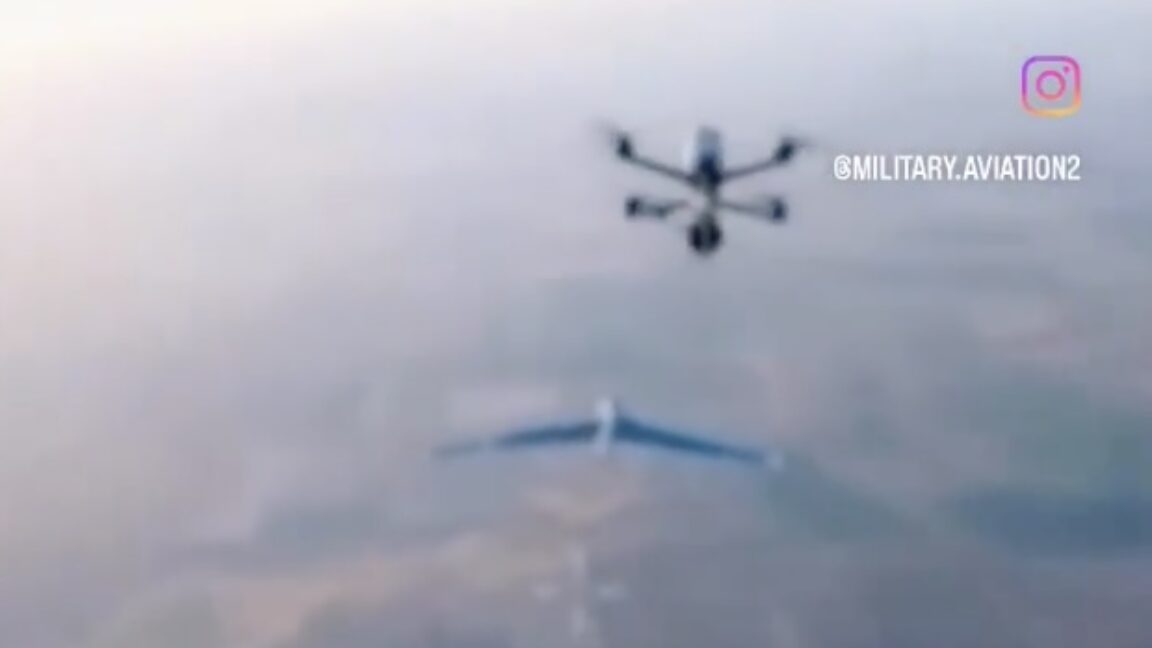
Drones are now launching drones to attack other drones in Ukraine
arstechnica.com
Drone wars Drones are now launching drones to attack other drones in Ukraine Under the pressure of war, the pace of innovation is quick. Nate Anderson Feb 4, 2025 5:57 pm | 19 Screenshot Story textSizeSmallStandardLargeWidth *StandardWideLinksStandardOrange* Subscribers only Learn moreLast time we checked in on terrifying drone developments in the Russian invasion of Ukraine, the Ukrainians were dropping molten thermite along Russian trench lines and attaching surface-to-air missiles to naval drones.Possessing a far smaller population than Russia, Ukraine has pinned its hopes in significant part on drone warfare, and hundreds of companies and organizations across the country are building everything from tiny aerial attack drones to massive ground-crawling, machine gun-toting minelayers. (And this is to say nothing of all the innovation happening in Western defense companies like AeroVironment.)Here are just a few of the drone warfare innovations that have appeared in public sources over the last few months.MothershipsUkraine has, for some time, fielded large "mothership" drones that can carry and eventually deploy a set of smaller attack drones. This approach can, for example, get light and fast FPV attack drones behind the front lines before releasing them, thereby extending the attack drones' limited range.But it was only this week that I came across footage of a mothership drone launching an attack drone to take down a much larger Russian surveillance drone. In the video, the mothership gets in position above and behind the Russian drone, then launches a small quadcopter drone that races toward the Russian drone and explodes. Fragments of both drones float down as the mothership films the action.Drones launching drones to attack other droneswelcome to war in 2025. A drone with two shotgun barrels, out hunting another drone. ShotgunsSince the start of the war, the Ukrainians have been strapping everything imaginable to their drones, from grenades to mines to RPGs to thermite. Given their recoil, guns have been a bigger challenge, but this hasn't stopped drone makers from trying.Recent footage suggests that real advances have been made in stabilizing the drone platform while firing; one viral video shows not one but two shotguns mounted to a drone, which zips around blasting three Russian drones before targeting an infantry member on the ground. Given the presence of two shotguns going off simultaneously, the drone's stability is impressive.This does not appear to be in mass production, though the Kyiv Post talked to an aerial scout who thought about the weapon's utility.Grenade launchersGrenade launchers have been tested on aerial drones, but they seem more suited to a ground platform. Enter the Burya, a small tracked drone with a grenade launching turret on top. The Burya can carry up to 64 grenades and use fire control software and gyro stabilization to aim and fire a grenade up to 100 meters. According to Ukraine's military, the system has already entered mass production and is being delivered to front-line units.What's next for the system? According to the developer, a Ukrainian company called Frontline, "We are planning to combine the turrets targeting system with data from reconnaissance UAVs [that is, drones] to transmit coordinates to the target in live mode."Assault riflesThey may be harder to aim accurately and may go through ammunition more quickly, but assault rifle drones are still being worked on. In September, the Kyiv Post reported on the most recent efforts to strap an AK-74 rifle to a drone and then go attack Russian trenches. A drone begins the process of stealing another drone. Magnet/clawOne recent video claims to show something even crazier than gunsa drone with a large retractable claw or magnet (it's not quite clear which) stealing another drone. Think of arcade-style claw grabber machines and you've got the idea.Radio mastThe Ukrainian military is talking up a new ground drone called the Pliushch, which doesn't carry a weapon but instead features a folded, 10-meter (32-foot) tall radio mast. The drone has a range of 40 km (25 miles), and once in position, it can raise the radio mast, which can be used either as a communications repeater or as a mobile electronic warfare station.The future of drone combatThese examples are really just a partial listit doesn't even touch on the continually updated naval drones that Ukraine continues to deploy in the Black Seaand for every new innovation, there will shortly be a counter-innovation. Case in point: electronic warfare has now saturated front-line combat areas in Ukraine and Russia and, in some places, is so bad that fiber optic drones are now used to avoid its effects. (These drones unspool miles of ultra-thin fiber-optic cable behind them as they fly, which provides a high-quality, unjammable video and control channel to the drone.)Because fiber optic drones lack the electromagnetic transmissions that can make drones easy to pinpoint, new methods (including short-range radar systems) are now used to hunt them down, while quick-reaction units will use small attack drones to hit the fiber optic drone before it reaches its target.Given the many kinds of drone hardware available, you might wonder why more assaults don't rely on machines rather than humans. Now that ground drones are entering the fight in greater numbers, this does appear to be happening. For instance, local news reports from Ukraine in December described how the Khartia brigade of the Ukrainian National Guard attacked Russian positions using only a mix of machine gun ground drones, aerial attack drones, and mine-laying/clearing drones.Nate AndersonDeputy EditorNate AndersonDeputy Editor Nate is the deputy editor at Ars Technica. His most recent book is In Emergency, Break Glass: What Nietzsche Can Teach Us About Joyful Living in a Tech-Saturated World, which is much funnier than it sounds. 19 Comments
0 Comentários
·0 Compartilhamentos
·55 Visualizações


